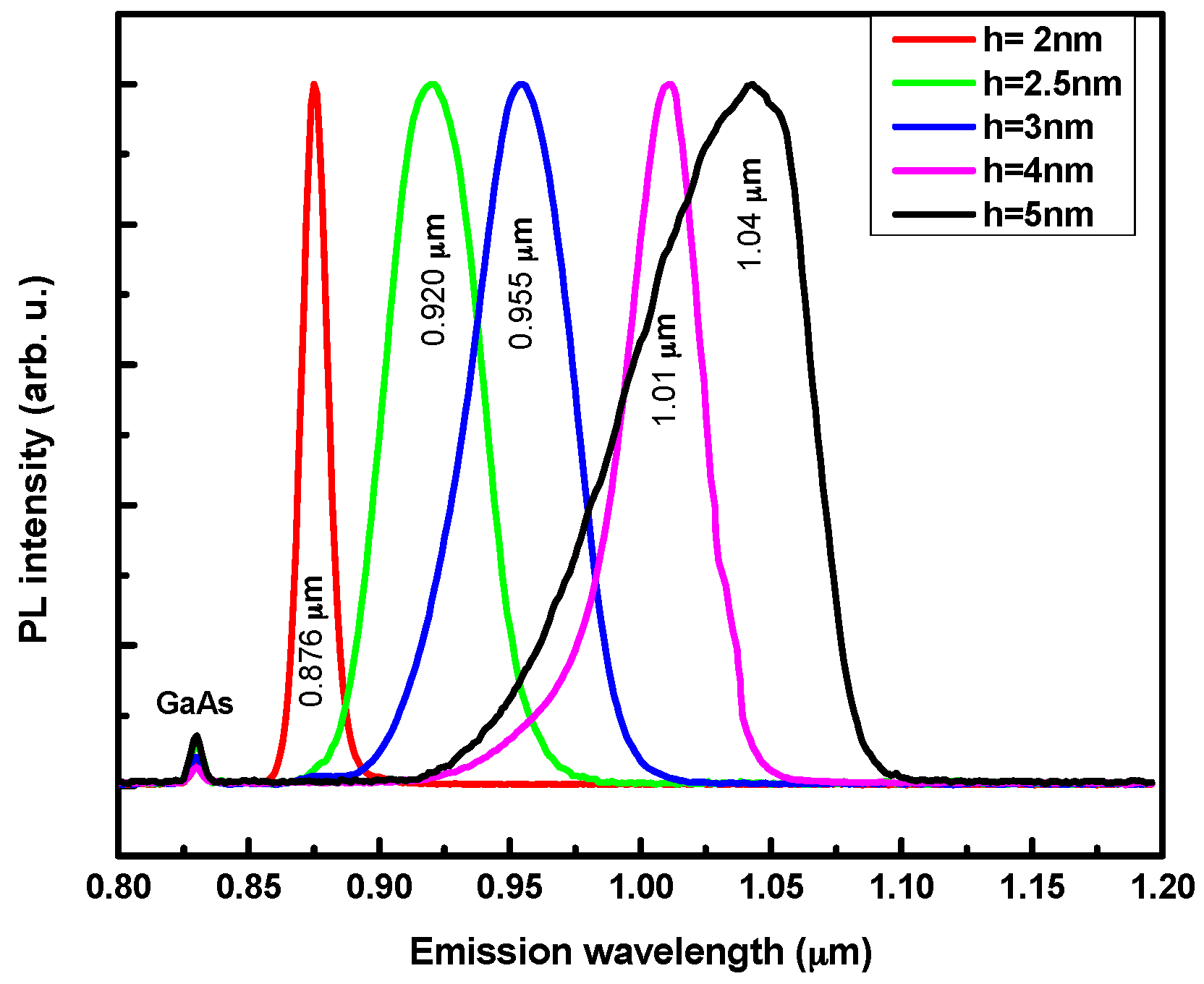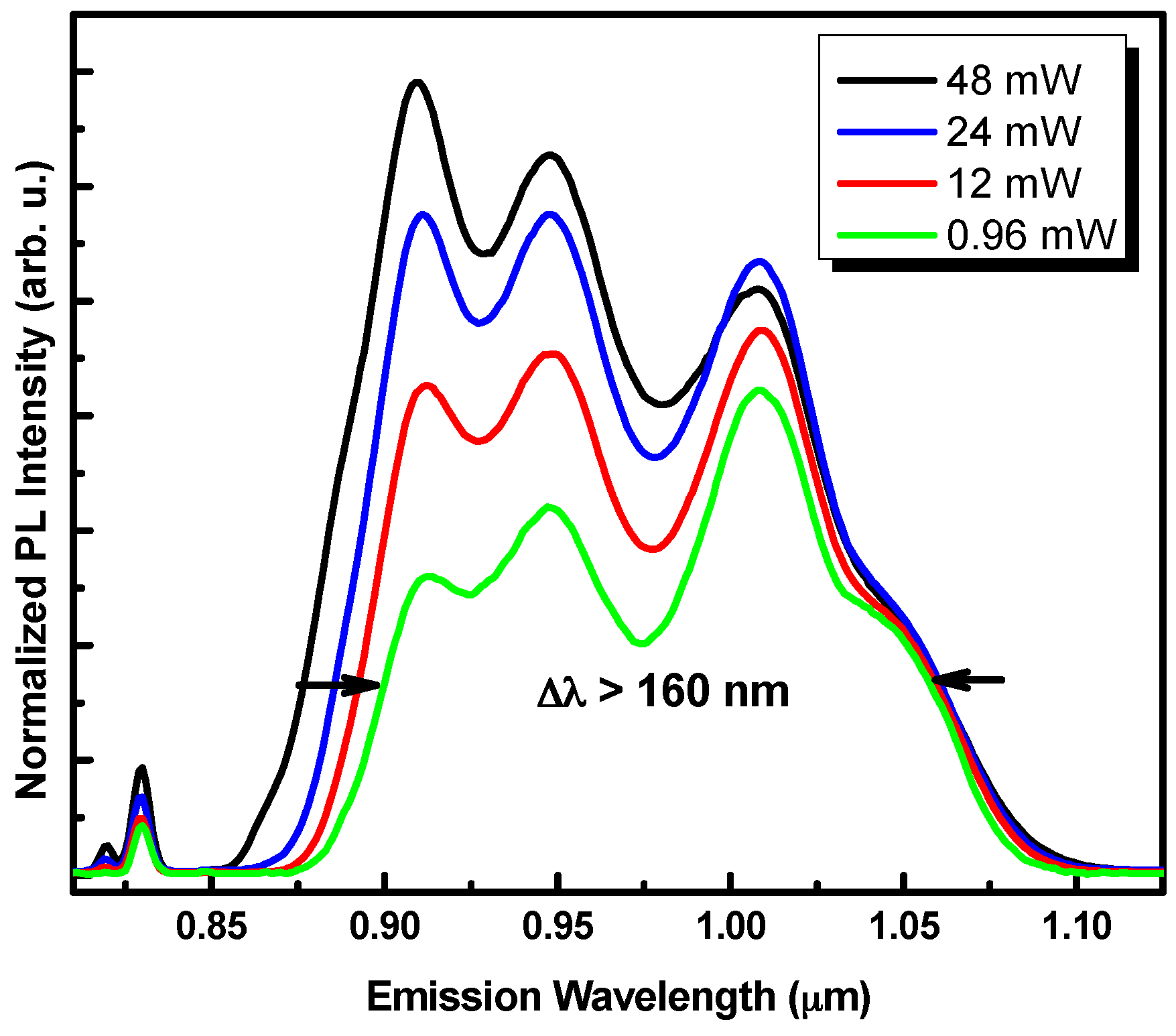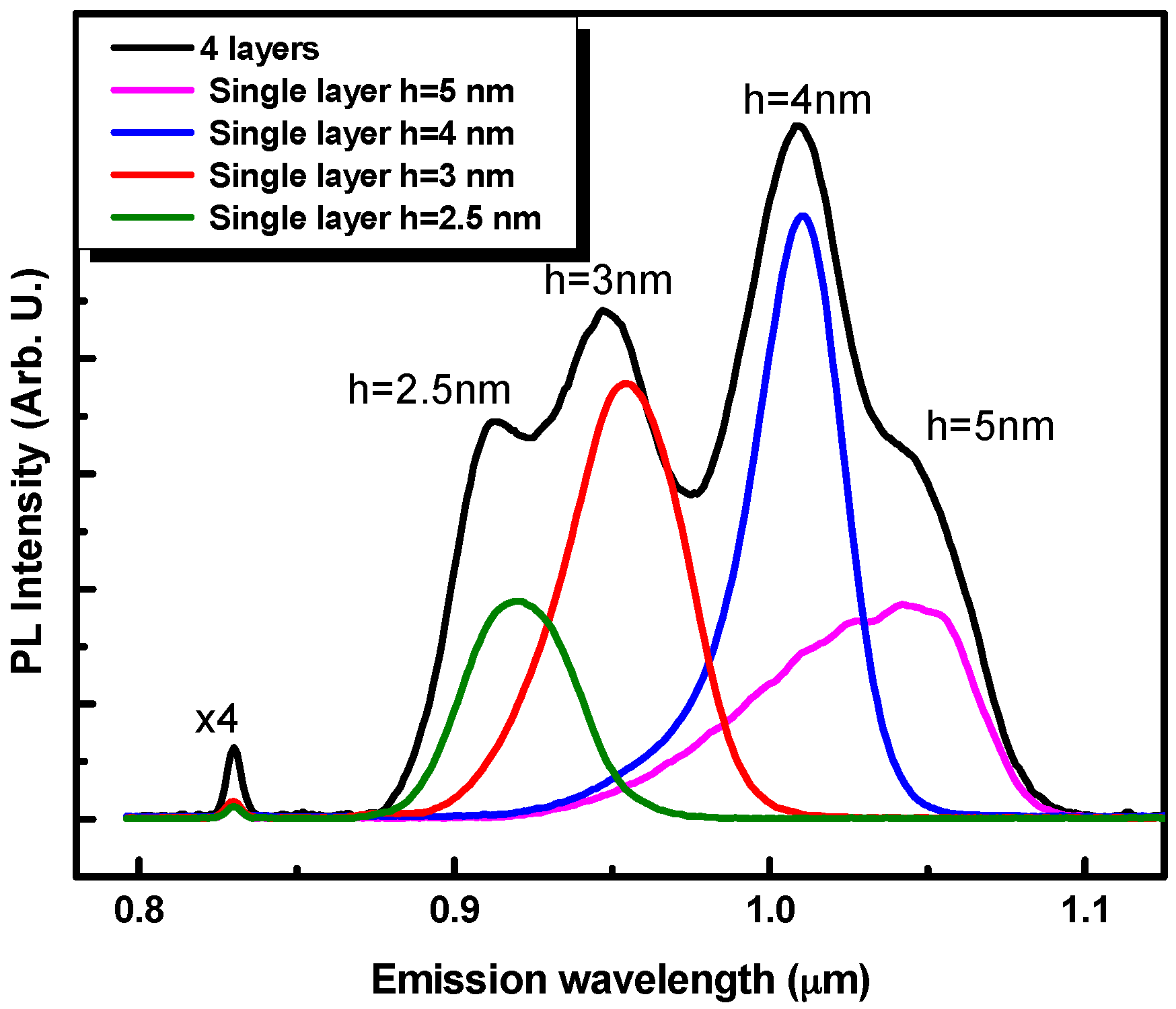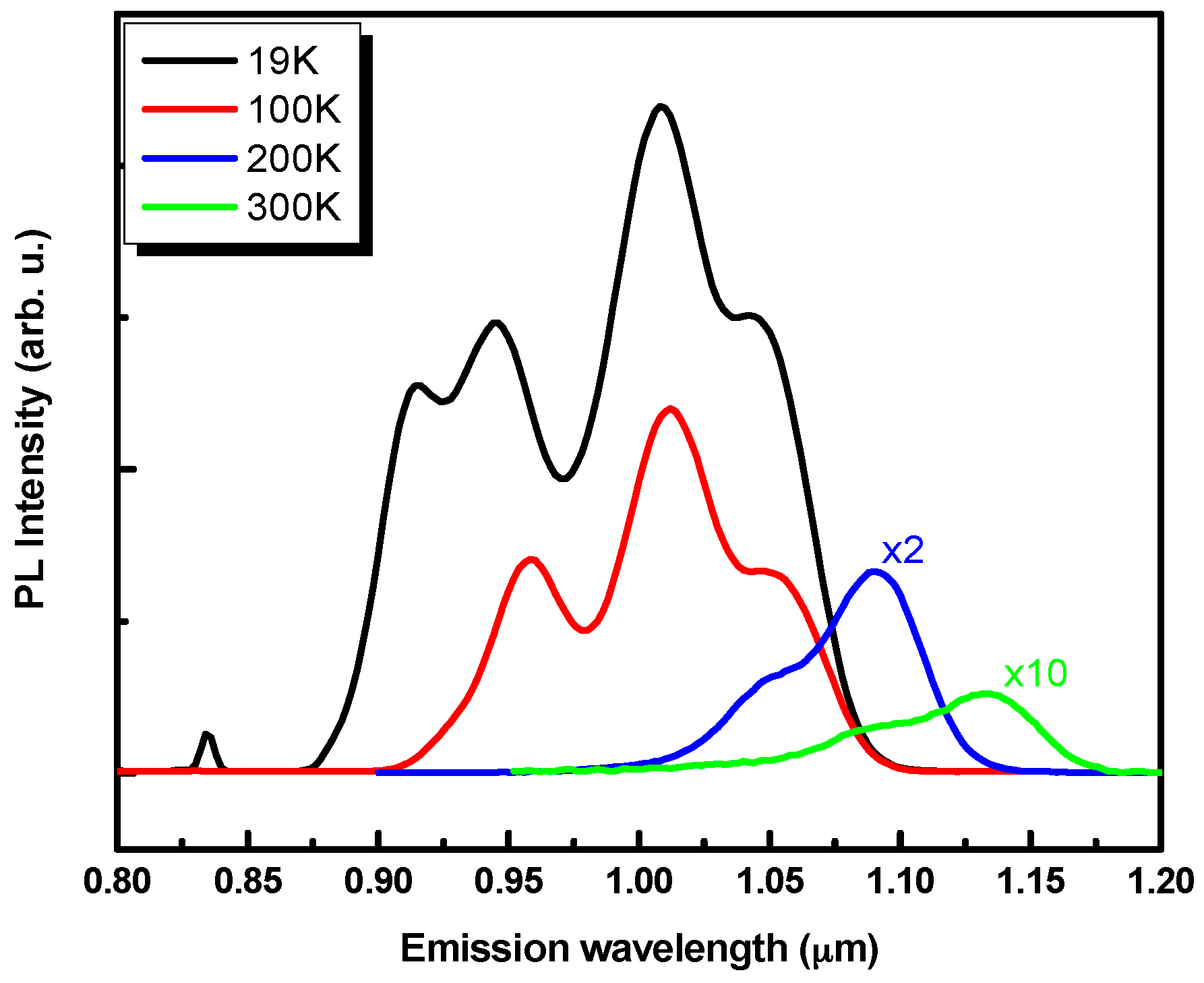Tunable Emission Wavelength Stacked InAs/GaAs Quantum Dots by Chemical Beam Epitaxy for Optical Coherence Tomography
Abstract
:1. Introduction
2. Results
2.1. Samples Growth
2.2. Height Truncation of Single QD Layer
2.3. Staked Layers of QD with Different Heights
3. Materials and Methods
4. Conclusions
Acknowledgments
Author Contributions
Conflicts of Interest
Abbreviations
| CBE | Chemical Beam Epitaxy |
| QD | Quantum dots |
| SLD | Superluminescent DiodeDirectory of open access journals |
| OCT | Optical Coherence Tomography |
| PL | Photoluminecsence |
| TMIn | Trimethylindium |
| TEGa | Triethylgallium |
References
- McLaughlin, R.A.; Scolaro, L.; Robbins, P.; Hamza, S.; Saunders, C.; Sampson, D.D. Imaging of human lymph nodes using optical coherence tomography: Potential for staging cancer. Cancer Res. 2010, 70, 2579–2584. [Google Scholar] [CrossRef] [PubMed]
- Nguyen, F.T.; Zysk, A.M.; Chaney, E.J.; Adie, S.G.; Kotynek, J.G.; Oliphant, U.J.; Bellafiore, F.J.; Rowland, K.M.; Johnson, P.A.; Boppart, S.A. Optical Coherence Tomography: The Intraoperative Assessment of Lymph Nodes in Breast Cancer. IEEE Eng. Med. Biol. Mag. 2010, 29, 63–70. [Google Scholar] [CrossRef] [PubMed]
- Povazay, B.; Bizheva, K.; Unterhuber, A.; Hermann, B.; Sattmann, H.; Fercher, A.F.; Drexler, W.; Apolonski, A.; Wadsworth, W.J.; Knight, J.C.; et al. Submicrometer axial resolution optical coherence tomography. Opt. Lett. 2002, 27, 1800–1802. [Google Scholar] [CrossRef] [PubMed]
- Tony, H.K.; Desmond, C.A.; James, G.F.; Dmitry, M.; Viatcheslav, P.; Vladimir, S.; Sergei, Y. Ultrahigh resolution optical coherence tomography imaging with a broadband superluminescent diode light source. Opt. Express 2004, 12, 2112–2119. [Google Scholar]
- Huang, D.; Swanson, E.A.; Lin, C.P.; Schuman, J.S.; Stinson, W.G.; Chang, W.; Hee, M.R.; Flotte, T.; Gregory, K.; Puliafito, C.A.; et al. Optical coherence tomography. Science 1991, 254, 1178–1181. [Google Scholar] [CrossRef] [PubMed]
- Ozaki, N.; Takeuchi, K.; Ohkouchi, S.; Ikeda, N.; Sugimoto, Y.; Oda, H.; Asakawa, K.; Hogg, R.A. Monolithically grown multi-color InAs quantum dots as a spectral-shape controllable near-infrared broadband light source. Appl. Phys. Lett. 2013, 103, 1–4. [Google Scholar] [CrossRef]
- Ozaki, N.; Yasuda, T.; Ohkouchi, S.; Watanabe, E.; Ikeda, N.; Sugimoto, Y.; Hogg, R.A. Near-infrared superluminescent diode using stacked self-assembled InAs quantum dots with controlled emission wavelengths. Jpn. J. Appl. Phys. 2014, 53, 1–4. [Google Scholar] [CrossRef]
- Shibata, H.; Ozaki, N.; Yasuda, T.; Ohkouchi, S.; Ikeda, N.; Ohsato, H.; Watanabe, E.; Sugimoto, Y.; Furuki, K.; Miyaji, K.; et al. Imaging of spectral-domain optical coherence tomography using a superluminescent diode based on InAs quantum dots emitting broadband spectrum with Gaussian-like shape. Jpn. J. Appl. Phys. 2015, 54, 1–5. [Google Scholar] [CrossRef]
- Salomatina, E.; Yaroslavsky, A.N. Evaluation of the in vivo and ex vivo optical properties in a mouse ear model. Phys. Med. Biol. 2008, 53, 2797–2807. [Google Scholar] [CrossRef] [PubMed]
- Sun, Z.-Z.; Ding, D.; Gong, Q.; Zhou, W.; Xu, B.; Wang, Z.-G. Quantum-dot superluminescent diode: A proposal for an ultra-wide output spectrum. Opt. Quantum Electron. 1999, 31, 1235–1246. [Google Scholar] [CrossRef]
- Rosseti, M.; Markus, A.; Fiore, A.; Occhi, L.; Velez, C. Quantum dot superluminescent diodes emitting at 1.3 μm. IEEE Photonics Technol. Lett. 2005, 17, 540–542. [Google Scholar] [CrossRef]
- Brezinski, M.E. Optical Coherence Tomography: Principles and Applications; Academic Press: Burlington, MA, USA, 2006. [Google Scholar]
- Fafard, S.; Wasilewski, Z.R.; Allen, C.N.; Picard, D.; Spanner, M.; McCaffrey, J.P.; Piva, P.G. Manipulating the energy levels of semiconductor quantum dots. Phys. Rev. B 1999, 59. [Google Scholar] [CrossRef]
- Ilahi, B.; Salem, B.; Aimez, V.; Sfaxi, L.; Maaref, H.; Morris, D. Post-growth engineering of InAs/GaAs quantum dots’ band-gap using proton implantation and annealing. Nanotechnology 2006, 17. [Google Scholar] [CrossRef]
- Zribi, J.; Morris, D.; Ilahi, B.; Aldhubaib, A.; Aimez, V.; Ares, R. In-situ height engineering of InGaAs/GaAs quantum dots by chemical beam epitaxy. J. Nanophotonic 2016, 10. [Google Scholar] [CrossRef]
- Patterson, M.S.; Wilson, B.C.; Wyman, D.R. The propagation of optical radiation in tissue. II: Optical properties of tissues and resulting fluence distributions. Lasers Med. Sci. 1991, 6, 379–390. [Google Scholar] [CrossRef]
- Hinz, T.; Ehler, L.-K.; Hornung, T.; Voth, H.; Fortmeier, I.; Maier, T.; Höller, T.; Schmid-Wendtner, M.-H. Preoperative Characterization of Basal Cell Carcinoma Comparing Tumour Thickness Measurement by Optical Coherence Tomography, 20-MHz Ultrasound and Histopathology. Acta Derm. Venereol. 2012, 92, 132–137. [Google Scholar] [PubMed]
- Nasr, O.; Alouane, M.H.H.; Maaref, H.; Hassen, F.; Sfaxi, L.; Ilahi, B. Comprehensive investigation of optical and electronic properties of tunable InAs QDs optically active at O-band telecommunication window with (In) GaAs surrounding material. J. Lumin. 2014, 148, 243–248. [Google Scholar] [CrossRef]
- Ustinov, V. InAs/InGaAsN quantum dots emitting at 1.55 μm grown by molecular beam epitaxy. J. Cryst. Growth 2003, 251, 388–391. [Google Scholar] [CrossRef]




© 2016 by the authors; licensee MDPI, Basel, Switzerland. This article is an open access article distributed under the terms and conditions of the Creative Commons Attribution (CC-BY) license (http://creativecommons.org/licenses/by/4.0/).
Share and Cite
Ilahi, B.; Zribi, J.; Guillotte, M.; Arès, R.; Aimez, V.; Morris, D. Tunable Emission Wavelength Stacked InAs/GaAs Quantum Dots by Chemical Beam Epitaxy for Optical Coherence Tomography. Materials 2016, 9, 511. https://doi.org/10.3390/ma9070511
Ilahi B, Zribi J, Guillotte M, Arès R, Aimez V, Morris D. Tunable Emission Wavelength Stacked InAs/GaAs Quantum Dots by Chemical Beam Epitaxy for Optical Coherence Tomography. Materials. 2016; 9(7):511. https://doi.org/10.3390/ma9070511
Chicago/Turabian StyleIlahi, Bouraoui, Jihene Zribi, Maxime Guillotte, Richard Arès, Vincent Aimez, and Denis Morris. 2016. "Tunable Emission Wavelength Stacked InAs/GaAs Quantum Dots by Chemical Beam Epitaxy for Optical Coherence Tomography" Materials 9, no. 7: 511. https://doi.org/10.3390/ma9070511
APA StyleIlahi, B., Zribi, J., Guillotte, M., Arès, R., Aimez, V., & Morris, D. (2016). Tunable Emission Wavelength Stacked InAs/GaAs Quantum Dots by Chemical Beam Epitaxy for Optical Coherence Tomography. Materials, 9(7), 511. https://doi.org/10.3390/ma9070511






